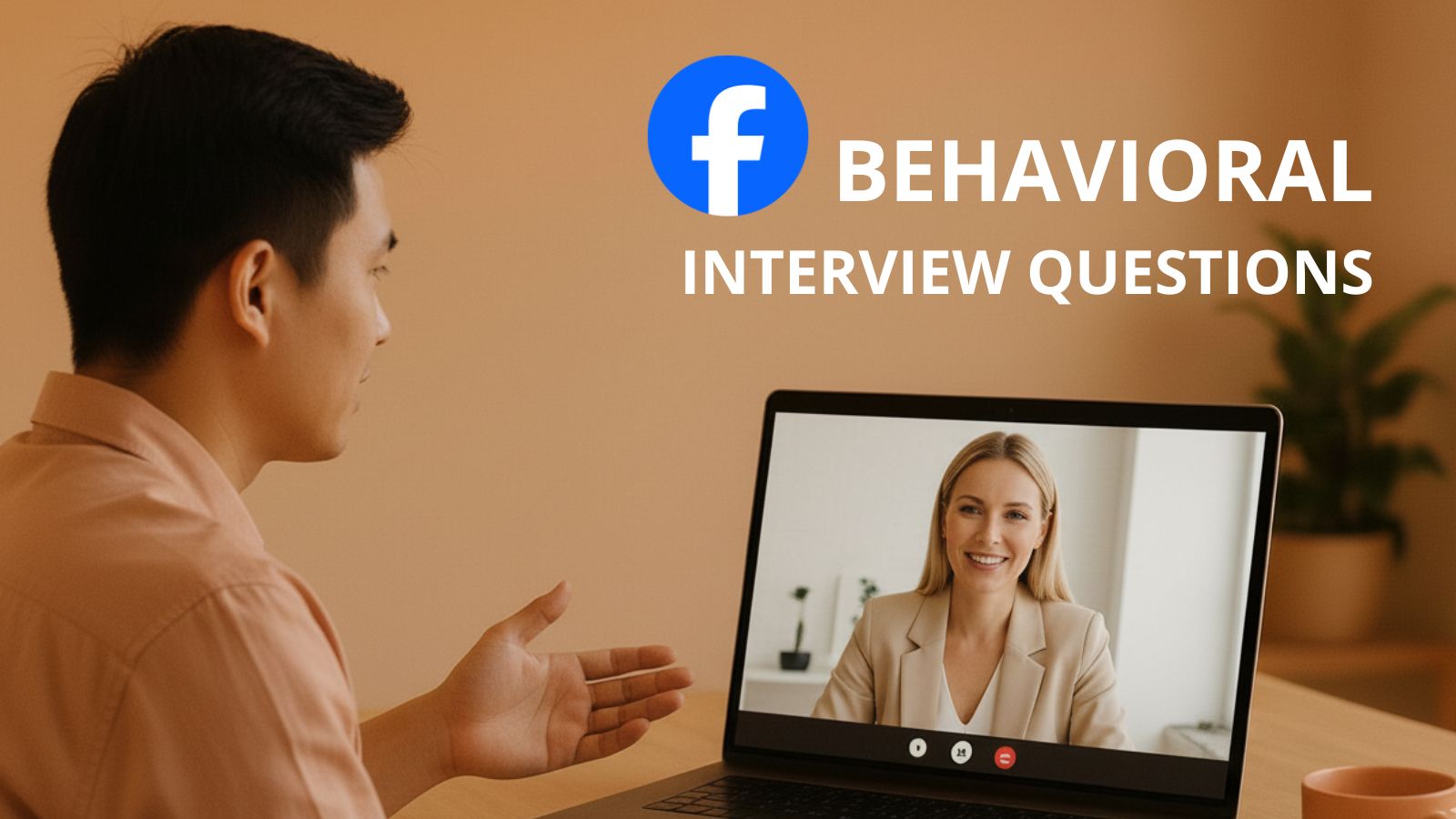S - Situation
Set the context. Where were you working? What was the project? Keep this brief, 2 to 3 sentences maximum.

Getting hired at Facebook means more than writing great code. Every year, thousands of talented engineers pass the technical screens but get rejected after behavioral interviews. Why? Because Facebook doesn't just hire for skills, they hire for culture fit, leadership potential, and the ability to deliver impact in complex environments.
If you're preparing for a Facebook interview, this guide will give you 20 real behavioral questions with detailed sample answers and provide a proven preparation strategy.
Facebook's interview process is rigorous and multi-layered. While the exact structure can vary by role, behavioral interviews are a constant across nearly all positions.
Typically, you'll go through an initial recruiter screen, followed by one or more phone/video interviews (often a mix of technical and behavioral), and then an onsite or virtual onsite loop.
The onsite usually includes four to six interviews covering coding, system design (for more senior roles), and behavioral assessments.
What's unique about Facebook's approach is their emphasis on structured interviewing. Every interviewer uses fixed rubrics to evaluate candidates consistently. This means your answers are assessed against the same criteria as everyone else's, which actually levels the playing field if you prepare smartly.
You might wonder why Facebook or any FAANG company puts such heavy weight on behavioral interviews. After all, isn't technical skill what really matters in a tech company?
Facebook has learned that behavioral interviews provide predictive value for future performance. The way you handled a conflict with a teammate in the past is a pretty good indicator of how you'll navigate similar situations at Facebook.
It's needed to understand that behavioral and technical rounds serve different purposes in Facebook's evaluation process.
Behavioral interviews focus on soft skills, how you work with others, lead initiatives, handle setbacks, and grow from experiences. Your interviewer wants to understand your thought process, emotional intelligence, and cultural fit.
In contrast, technical rounds assess your hard skills: coding ability, algorithm knowledge, system design thinking, and problem-solving under technical constraints.
That’s why both types of interviews matter equally in the hiring decision.
To nail behavioral interviews, you need to internalize what the company values. Facebook's values have evolved, but several principles remain constant:
When crafting your behavioral responses, weave these values into your stories.
Before diving into specific questions, you need to understand the STAR method. This is the structure interviewers expect, and it's how you'll organize every behavioral answer.
S - Situation: Set the context. Where were you working? What was the project? Keep this brief, 2 to 3 sentences maximum.
T - Task: What was your specific responsibility or challenge? What were you trying to achieve?
A - Action: This is the most important part. What specific steps did you take? What decisions did you make? The interviewer needs to understand your individual contribution, not just what the team did.
R - Result: What happened? Quantify whenever possible. Did you ship on time? Improve a metric?
The STAR structure forces you to be specific, quantify impact, and highlight your individual contribution.
Below are 20 behavioral questions that have been reported by actual Facebook candidates, along with a sample answer that explains what they want to hear.
Sample Answer: "In my second year as a backend engineer, I pushed a database migration to production without adequate load testing. The service went down for three hours during peak traffic. I learned the importance of staging environments that mirror production load, and I led an initiative to improve our testing infrastructure. Since then, we haven't had a similar outage."
Sample Answer: “I led a cross-team project with tight deadlines (Situation). I coordinated tasks and resolved conflicts (Task & Action), ensuring open communication and support. Despite challenges, we delivered on time with 15% efficiency improvement (Result), and the team praised the collaborative approach.”
Sample Answer: "My manager wanted to prioritize a feature I thought was lower impact than another initiative. I gathered user data and projected ROI for both options, presented my case in a one-on-one, and we decided to run a small A/B test. The data supported my recommendation, and we shifted priorities."
Sample Answer: "A teammate was consistently missing deadlines, which blocked my work. Instead of escalating immediately, I scheduled a coffee chat to understand what was going on. Turns out they were overwhelmed with technical debt in their area. We pair-programmed to clear some blockers and adjusted our project timeline together. We then delivered the project successfully."
Sample Answer: "We had to choose between two third-party APIs for a feature launch in two weeks, but neither had complete documentation. I set up quick prototypes for both, ran performance benchmarks, and consulted with a senior engineer who'd used one before. I made the call based on speed and community support. It worked well, and we shipped on time."
Sample Answer: "I was juggling a bug fix, a new feature for a product launch, and code reviews for my team. I assessed impact: the bug affected 10% of users, the feature was tied to a public launch, and code reviews could wait a day. I fixed the bug first, then worked late to finish the feature. I communicated the delay on reviews to my team, and everyone understood."
Sample Answer: "During a performance review, my manager said my communication in meetings was too technical for non-engineers. I started practicing explaining concepts in simpler terms, asked for feedback after cross-functional meetings, and even took an internal course on stakeholder communication. The next quarter, my manager noted improvement."
Sample Answer: "I noticed our team's onboarding docs were outdated, and new hires were struggling. Even though it wasn't my responsibility, I spent a few hours each week updating them, recording walkthroughs, and organizing a wiki. Onboarding time for new engineers dropped from three weeks to one, and the manager gave me a company award for the initiative."
Sample Answer: "Our PM left mid-project, and requirements were unclear. I organized a quick meeting with stakeholders to align on the must-have features, created a lightweight spec, and got sign-off. We scoped down to an MVP and shipped in time for the company event it was tied to. The project led to a 15% increase in user engagement."
Sample Answer: "I needed the data engineering team to prioritize a pipeline for my feature, but I had no formal authority. I showed them how the pipeline would also benefit two other teams and reduce the overall maintenance burden. I offered to write the initial version if they'd review and support it. They agreed, and we collaborated successfully."
Sample Answer: "We had a tight launch deadline. I proposed shipping a solid MVP with well-tested features, deferring nice-to-haves to a v2. We released on time with no major bugs, then iterated based on user feedback. The phased approach let us move fast without compromising stability."
Sample Answer: "Our team's code review process was slow, PRs sat for days. I introduced a Slack bot that notified reviewers and tracked average review time. We gamified it a bit, and review time dropped from 48 hours to under 12. The team was happier."
Sample Answer: "A PM requested a feature that would take two sprints but only serve a tiny user segment. I presented data showing that an alternative feature would impact 10x more users with similar effort. We discussed trade-offs, and they agreed to pivot. That feature became one of our most-used."
Sample Answer: "I worked with design, product, data science, and marketing to launch a new engagement feature. I set up a shared Slack channel, ran weekly syncs, and made sure everyone understood technical constraints early. The launch was smooth, and we hit our engagement goals in the first month."
Sample Answer: "Midway through a project, our tech stack changed from REST APIs to GraphQL company-wide. I quickly upskilled by taking internal courses and reading docs, refactored our service, and even helped a teammate transition their code. We stayed on schedule even though the change."
Sample Answer: "I underestimated the difficulty of integrating a third-party service and missed a sprint deadline by three days. I communicated the delay early, worked extra hours to close the gap, and afterward created a more detailed estimation process for our team that reduced future misses."
Sample Answer: "A junior engineer on my team struggled with system design. I paired with them weekly, walked through real examples, and reviewed their design docs. Within two quarters, they were confidently leading smaller design discussions and got promoted."
Sample Answer: "A service went down an hour before a major product demo to executives. I stayed calm, coordinated with the on-call engineer, identified the root cause (a config error), and deployed a fix in 30 minutes. The demo went ahead smoothly, and I wrote a postmortem to prevent recurrence."
Sample Answer: "I needed to learn React Native for a mobile project within two weeks. I took an online course, built a small side project, and leaned on a teammate who was experienced. I was productive on the project by week three and later became the go-to person on the team for React Native questions."
Sample Answer: "I decided to deprecate a legacy feature that a vocal minority of users loved but cost us maintenance burden and slowed velocity. I communicated the rationale transparently, offered migration support, and most users adapted. Our team's velocity improved by 20%, allowing us to ship more features with impact."
Preparing for behavioral interviews is about deeply understanding your own experiences and being ready to articulate them in a way that demonstrates Facebook's values and competencies.
Start by researching Facebook culture. Go beyond the careers page: read employee reviews on Glassdoor, follow their engineering team on social media, watch talks by their leaders on YouTube, and, if possible, talk to current or former employees.
Understanding the company's pace, priorities, and challenges will help you frame your stories appropriately.
Next, find your stories. List out projects, challenges, failures, and wins from your career.
Preparation for answers for behavioral interviews should be highly structured and align with the company's published values.
Practice articulating these stories using the STAR method (Situation, Task, Action, Result). Record yourself or practice with a friend.
Facebook's behavioral interviews are designed to go deep, to understand not just what you've accomplished, but how you think, collaborate, and grow.
Preparation is everything. You can't wing behavioral interviews at this level. Take the time to reflect on your experiences, structure them using STAR, and practice until your stories feel natural.
The 20 questions and sample answers will give you a strong foundation. But your own experiences and authentic voice are what will set you apart.

Learn how to answer the question "Who are you?" with confidence. Get tips and examples to craft a compelling and authentic response.

Discover effective strategies to confidently answer the interview question, "Why did you leave your last job?" and make a positive impression.

Discover effective strategies and examples to confidently answer "Why do you want to be a nurse?" in your next interview.

Learn how to answer the tricky interview question "What Makes You Angry?" with expert tips and examples to impress your potential employer.